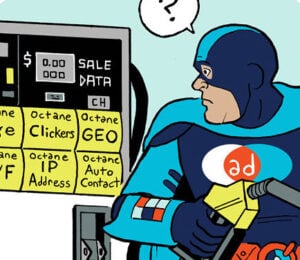With over $200 billion in programmatic spending on the table next year, maximizing yield is the name of the game for publishers in 2026. Capturing that opportunity demands maximum optionality across demand paths and signals. And with AI reshaping the landscape (referrals from ChatGPT to news publishers saw a 25x increase from the first half of 2024 to the first half of 2025, while traditional search traffic heads in the other direction) it is more important than ever for publishers to optimize their monetizable inventory.
Yet, the crux of the measurement challenge remains a historical lack of provider transparency, rooted in a natural hesitance for publisher tools to be inclusive of a competitive solution’s performance.
That’s changing. Today, leading providers are championing a radical openness inspired by the notion that when we raise the bar together, everyone benefits from collective progress and shared innovation. This true transparency is opening the gates for a new generation of measurement and reporting tools, giving publishers a practical, repeatable, data-driven approach to harnessing maximum optionality and optimizing revenue.
3 key changes powering publishers’ revenue future
1. Demand-path reporting: Your supply chain, clearly illuminated
Publishers have long lacked clear, demand-side visibility into monetization paths – with visibility usually restricted to one’s immediate buyer in the supply chain. This opacity, preventing insight into advertiser spend via specific SSPs or at specific rates, hindered informed decision-making for direct deals, waterfall fine-tuning and overall supply setup.
Next-gen measurement tools bring clarity. Publishers can now see precisely how advertiser dollars reached them through every demand path. This includes granular insights into impressions, revenue, specific advertisers, auction type (open vs. private marketplace) and media format.
This rich information enables publishers to rationalize payouts, identify high-value demand and confidently pursue direct deals, eliminating intermediary fees.
2. Header bidding interoperability: Unifying a formerly fragmented ecosystem
Header bidding, while initially intended to bring more transparency and competition, paradoxically worsened visibility. Publishers sought open-source flexibility, but integrating all major demand sources seamlessly without latency or bid request duplication was a constant battle. Header bidding often felt like a skirmish of competing, proprietary technologies.
Today, top providers have collaborated to solve this fragmentation and enabled true header bidding interoperability. The technical “solve” allows different software development kits (SDKs) to act as intelligent routers, enabling publishers to fluidly choose integration methods. Crucially, this happens without adding latency or duplicating bid traffic.
These advancements allow publishers to embrace server-to-server bidding, leading to faster auctions, better bid management and potentially higher yield – finally simplifying a previously complex, fragmented system. The header bidding war is effectively over, and everyone’s invited to the table.
3. Signal value measurement: Unlocking addressability’s true potential
The most radically simple innovation is the emergence of new signal value measurement tools that finally deliver what publishers have demanded: rigorous analysis of bidstream signals through always-on holdout testing.
These next-gen tools provide an out-of-the-box, automated A/B testing framework that perpetually runs vast numbers of experiments. This gives publishers granular, bidder-level insights – without the volatile revenue and inaccuracies often associated with manual, intrusive testing. These tools can subtly suppress a specific signal for a tiny fraction of impressions to understand its true, measurable revenue lift.
This reliable, continuous measurement gives publishers precise bid rate data to inform smarter, more targeted investments – and shorten their time to value. In fact, we’ve seen publishers in test groups achieve more than a 29% increase in earnings from their signal investments – and in one example, publishers achieved a 40% lift in revenue from just one signal. It’s a smarter approach to measuring supply-side signals, plain and simple.
Making it real: How industry leaders are delivering
At Amazon, we have supported the industry’s shift toward greater transparency and more advanced measurement for publishers. Recognizing existing tools couldn’t adequately address the evolving landscape – including new complexities and opportunities presented by AI – we developed new solutions. We did so both because our publisher partners need them and because we believe in leading by example.
Through Amazon Publisher Services’ (APS) Demand Channel Reporting, we’re helping publishers understand how advertiser spend reaches them by offering DSP-level metrics so they can rationalize pricing, payouts and pursue optimal deal paths.
We’ve also taken a collaborative approach, improving header bidding interoperability. The APS Prebid adapter allows publishers to integrate their existing Prebid setups with broader demand, leveraging server-to-server bidding without added latency or bid duplication. This directly solves the fragmentation that has plagued header bidding implementations for years.
And with the general availability launch of APS Signal IQ, publishers gain an always-on A/B testing framework so they can truly understand the performance of their bidstream signals. This complements our Connections Marketplace, which allows publishers to implement and test new identity vendors and other third-party ad tech services with just a few clicks and no code, making activation easier and billing more transparent.
Our belief is that providing honest insight – even when it points elsewhere – drives innovation across the industry that benefits stakeholders on all sides.
(Finally) realizing the promise of data-driven decisions
In an era in which AI can rapidly shift content value and audience behavior, data-driven strategic allocation is more vital than ever. Thankfully, the era of publishers operating without clear, comprehensive data on their monetization efforts is drawing to a close. The vast array of monetization options can now be navigated with actionable insights, clearly indicating the most valuable paths forward.
The radical embrace of transparency underpinning this shift represents an exciting new era for ad tech – one that genuinely empowers publishers with actionable insights instead of just adding more layers to an already complex stack.
This paradigm shift compels both advertisers and publishers to fundamentally rethink what they once considered insurmountable limitations in revenue optimization. The path forward is clear: Embrace transparency, demand data-driven insights, champion true optionality and (finally) realize the promise of data-driven decision-making.
For more articles featuring Scott Siegler, click here.
















